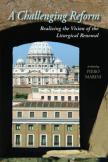Consilium Versus Curia
Archbishop Piero Marini served as the leading liturgist of the Holy See for 25 years. As master of papal liturgical ceremonies and as secretary/confidant to Archbishop Annibale Bugnini, the chief architect of the liturgical reform that followed the Second Vatican Council, Marini now presents the inside story of the fierce struggle fought within the Vatican to implement the liturgical restoration overwhelmingly approved by the council fathers. Written with firsthand knowledge, A Challenging Reform details the Curia’s opposition and its tactics to reverse the direction set by the “Constitution on the Sacred Liturgy.”
Carefully documented, critically analyzed and candidly presented, Marini’s book reflects a historical memory of the clashes and conflicts between the anti-reformists and reformists over the interpretation and implementation of the liturgy constitution. Edited by three well-known liturgical and linguistic scholars—Mark Francis, C.S.V., John Page and Keith Pecklers, S.J.—A Challenging Reform is the best single-volume overview of the beginning of the liturgical reform. The first six chapters are devoted to the formative period of the liturgical restoration. The seventh chapter examines the developments after this initial reform (1965-80). The appendix contains the text of seven pivotal documents that are valuable resources for understanding the context of the reform.
To assist in implementing the “Constitution on the Sacred Liturgy,” Pope Paul VI established a group known as the Consilium. It was international, competent, collegial and productive: it generated reformed liturgical texts. But the Consilium met immediate opposition from the Congregation for Rites. As Marini notes:
The Consilium and the Congregation for Rites championed two different perspectives. The Con-silium remained true to its mission in support of a liturgy open to renewal. The Congregation for Rites was still firmly anchored to a limited tradition since the Council of Trent and not in favor of the broad innovations desired by the Council.
The suspicion and stress encountered by the Consilium in interacting with the congregation point out a basic failure in ecclesiology that persists to this day: a collegial mindset versus a Curial mindset. This was clearly evident at the very beginning of the liturgical reform, when there was strong, strident curial opposition to the conciliar endorsement of the vernacular. The Congre-gation for Rites sought to limit its use and to deny bishops’ conferences the right to approve vernacular texts. The congregation opposed the use of the vernacular for prefaces and eucharistic prayers. Only with the en-dorsement of Pope Paul VI did the views of the Consilium finally prevail.
The Consilium also experienced a frontal attack from the Curia, with the unprecedented public opposition of Cardinals Alfredo Ottaviani and Antonio Bacci. Their statements reveal the re-trenchments so embedded in the Curia of that time. Marini’s book fosters in the reader a new esteem for the liturgical re-formers and their efforts to make the liturgy more res-ponsive to pastoral concerns and biblical sources. They paid a personal price for their efforts, but they gave new liturgical life to the universal church.
Archbishop Marini has rendered a great service to the contemporary church and succeeding generations by documenting so clearly the birth pains of the liturgical reform of Vatican II. He takes us behind the scenes, showing the role played by Cardinal Giacomo Lercaro and the Rev. (later Archbishop) Bugnini in fighting against efforts of the Congregation for Rites to derail the reform. For example, even though the council had restored concelebration in the Western church for wider use, the congregation was still restricting the number of concelebrants and insisting on the use of a metal straw, excluding drinking directly from the chalice.
Thanks to Marini’s book, we now appreciate all the more something we often take for granted: the restoration of the vernacular, “noble simplicity” in the rites, concelebration and reformed liturgical books (Roman Missal, Roman Pontifical, Ceremonial of Bishops, Liturgy of the Hours). He gives us a deeper appreciation of the enormous work that led to “full, conscious and active participation”—the prayer of the faithful, the rediscovery of the priesthood of all the faithful, the Novus Ordo and the recognition of various liturgical ministries entrusted to the laity.
All this did not happen without painstaking research and scholarly study, much dialogue and debate, and always countless meetings. This rich liturgical legacy of Vatican II has nourished the church’s worship for almost 40 years.
But are we seeing signs today of retrenchment, a return to a liturgical practice and piety from before Vatican II? Do we see signs of a preconciliar mentality, a Curial ecclesiology, influencing the liturgy? Are there parallels between the first days of the renewal and the present time? Marini’s book is a wake-up call to contemporary Catholics to sustain the liturgical achievements of the Second Vatican Council so that the past does not repeat itself. Will we learn that lesson of history and imitate those who fought so tirelessly to preserve and hand on the principles of the “Constitution on the Sacred Liturgy”?
When the Curia attempted to limit the liturgical reform, there was decisive and strong reaction from episcopal conferences and national liturgical commissions, especially from the French. Analyzing this, Marini writes: “Even during this initial phase of reform, the liturgy was no longer an exclusive preserve of the Roman Curia but belonged to the Church.” That remains the goal for the liturgy today. We are indebted to Archbishop Marini for his chronicle of the events that brought about what is perhaps the most fundamental liturgical reform in the history of the Western church.
This article also appeared in print, under the headline “Consilium Versus Curia,” in the April 14, 2008, issue.








